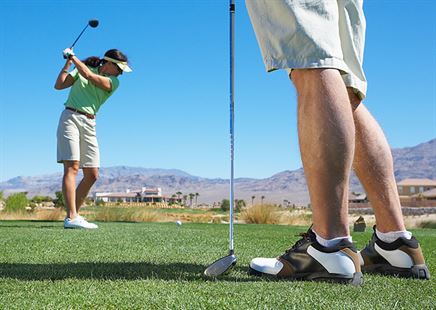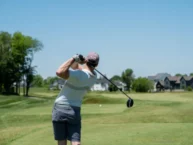Every golfer with any sense will tell you that the driver, the #1 club in your bag is also the #1 club most difficult to hit well, consistently. Consistently, being the operative word. Today drivers are big, honky things at the end of a very long, light shaft. Club manufacturers are always making little tweaks and improvements to make the driver work more efficiently and do what it is designed to do: get the ball as far down the fairway as you can possibly drive it.
 I have owned three different drivers. My first came with my “off the shelf” set of clubs. It was a 10 degree. I had no clue what that meant, or how difficult a 10 degree club is to hit well. The degree number refers to the “loft” or angle of the club face. Imagine a 0 degree club would have a face that is absolutely flat, perpendicular to the ground. The only thing you can do with it is push balls along the grass. They don’t make a 0 degree club as far as I know. But they do make them with faces set as low as 7 degrees.
I have owned three different drivers. My first came with my “off the shelf” set of clubs. It was a 10 degree. I had no clue what that meant, or how difficult a 10 degree club is to hit well. The degree number refers to the “loft” or angle of the club face. Imagine a 0 degree club would have a face that is absolutely flat, perpendicular to the ground. The only thing you can do with it is push balls along the grass. They don’t make a 0 degree club as far as I know. But they do make them with faces set as low as 7 degrees.
Most pros and very good golfers use clubs with a degree between 8 and 10 degrees. With the right swing and contact, these pros can send the ball 350 + yards or more down the fairway. (The longest drive ever recorded in a regulation golf match was set back in 1974 by a golfer named “Mighty” Mike Austin. He hit a 515 yard drive! If you take into consideration the Longest Drive Championships, that honor belongs to Mike Dobbyn who hit 551 yards and is the Long Drive Champion. Of course, if you want to get really technical, John Daly actually holds the longest drive ever recorded of 806 yards… but it was a special event at the LA Airport, and he was hitting down a runway with lots of great bounces and rolls thrown in for good measure. Must have been fun to watch.)
My second driver was a 16 degree. The pro thought if I couldn’t hit a low degree, why not give me a high one. But 16 is very high. And that’s what happened to all my balls. They would fly high and shallow. I was lucky to sell that club and with the money, bought my third driver, with a 12 degree loft. And I think you will find that most amateur golfers are using drivers with this “in-between” loft. This 12 degree club I can hit, though not consistently.
Which brings me to the subject of this post: What’s the right way to swing the driver? – and every other club in your bag for that matter?
I just took a lesson on hitting the driver from LPGA pro Sue Kaffenburgh. Her instruction always starts with the basics: cause and effect. Forget all the myths you’ve been taught and the usual “one-liners” about keeping your arm straight, letting the ball get in the way of your swing, turn your hips, etc. There is too much to think about, and most of it is bogus or unnecessary.
The key is to start with the proper grip. Once you have your grip set, stand behind the ball and find your target line. An easy trick is to spot a small leaf or broken tee somewhere on the line between your ball and your target, then move to beside the ball, take your normal stance and align your club face perpendicular to that spot.
Check to be sure that your stance is not too wide (shoulder width is the max) and that the ball position is in line with the inside of your forward foot. Your hands should grip the club and hang down naturally in the center of your body. The shaft of the driver is the longest of all your clubs, but don’t stretch out too far. The stance should feel comfortable.
Lock your lower body to the ground. Think cement. (I know you’ve heard about turning your hips, but that follows AFTER you begin to turn your upper body. Your body will turn naturally. Don’t consciously start with the hips.)
Focus on the club and the feel of it at the end of your club shaft and think of your right hand (in the case of a right handed golfer) as an extension of the club head. (The swing thought is to bring your “hand/club” back, load it with power and then return to the bottom of your swing, keeping your “hand/club” square to the ball.) And don’t worry about keeping your left arm straight. The key moment when you want that arm to be straight is at impact. If you imagine your right hand as the club head, when it swings back to the ball, it will just naturally be straight as an arrow.
Keep your head down and focused on the ball as your arms swing up and away.
As you begin your takeaway, keep your forward arm locked to the side of your torso. You don’t want your elbow flying around or any daylight between your forward arm and your side. Sue uses the image of a $100 bill tucked in under your arm. If you drop it while you swing, you loose it. (This thought helps with motivation!)
Turn your upper torso away from the target so that your sternum is pointing away. Don’t just turn your shoulders or swing your arms alone. Turn the entire upper torso, all the while keeping your lower body as still as you can and your forward arm tight against the side nearest the target.
What happens next just naturally folllows: as you turn your upper torso away from the target your weight naturally moves to that side. For a right handed golfer, the weight shifts to the right. As this happens the hips will begin to turn slightly.
At the top of your swing, cock your wrists (think hitchiker begging a ride.) Feel the weight of the clubhead at the end of the shaft and then swing down to the ball, hitting it on the perfect spot to send it flying up and far down the fairway. Your swing will naturally pull your body through to the finish, your weight now shifted to your forward foot and your sternum facing the target.
If everything is working in sync and the golf gods are kind, you will have made a great shot!
Resource: You might find this article helpful. It has a simple animation that illustrates each of the steps we’ve explained above. Golf Full Swing.
. . . . .
What do you think? Is your golf driver the hardest club in your bag? Do you give it up and use the 3-wood when you just can’t hit it well?




